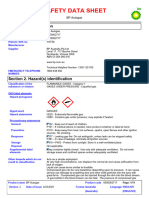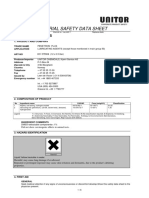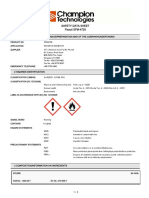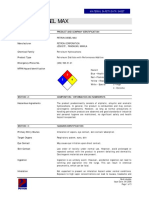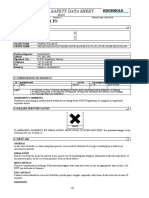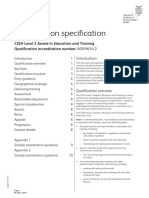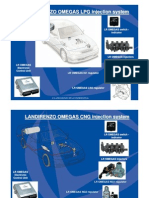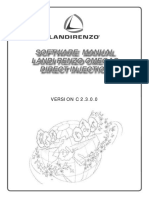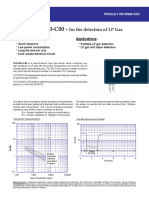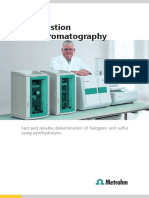0 ratings0% found this document useful (0 votes)
62 viewsPlease Ensure That This MSDS Is Received by The Appropriate Person
Please Ensure That This MSDS Is Received by The Appropriate Person
Uploaded by
Sainu KalathingalThis document provides a material safety data sheet for liquefied petroleum gas and propane. It lists the product identification and company details. The main hazards are that the gas is highly flammable, can displace oxygen and cause asphyxiation, and contact with the liquid can cause frostbite or severe burns. In the event of a leak or spill, all ignition sources should be eliminated and the area evacuated. Firefighting instructions warn that water should not be used and cylinders may explode if exposed to fire.
Copyright:
© All Rights Reserved
Available Formats
Download as PDF, TXT or read online from Scribd
Please Ensure That This MSDS Is Received by The Appropriate Person
Please Ensure That This MSDS Is Received by The Appropriate Person
Uploaded by
Sainu Kalathingal0 ratings0% found this document useful (0 votes)
62 views2 pagesThis document provides a material safety data sheet for liquefied petroleum gas and propane. It lists the product identification and company details. The main hazards are that the gas is highly flammable, can displace oxygen and cause asphyxiation, and contact with the liquid can cause frostbite or severe burns. In the event of a leak or spill, all ignition sources should be eliminated and the area evacuated. Firefighting instructions warn that water should not be used and cylinders may explode if exposed to fire.
Original Description:
LPG-Propane266_122438266_402892
Original Title
LPG-Propane266_122438266_402892
Copyright
© © All Rights Reserved
Available Formats
PDF, TXT or read online from Scribd
Share this document
Did you find this document useful?
Is this content inappropriate?
This document provides a material safety data sheet for liquefied petroleum gas and propane. It lists the product identification and company details. The main hazards are that the gas is highly flammable, can displace oxygen and cause asphyxiation, and contact with the liquid can cause frostbite or severe burns. In the event of a leak or spill, all ignition sources should be eliminated and the area evacuated. Firefighting instructions warn that water should not be used and cylinders may explode if exposed to fire.
Copyright:
© All Rights Reserved
Available Formats
Download as PDF, TXT or read online from Scribd
Download as pdf or txt
0 ratings0% found this document useful (0 votes)
62 views2 pagesPlease Ensure That This MSDS Is Received by The Appropriate Person
Please Ensure That This MSDS Is Received by The Appropriate Person
Uploaded by
Sainu KalathingalThis document provides a material safety data sheet for liquefied petroleum gas and propane. It lists the product identification and company details. The main hazards are that the gas is highly flammable, can displace oxygen and cause asphyxiation, and contact with the liquid can cause frostbite or severe burns. In the event of a leak or spill, all ignition sources should be eliminated and the area evacuated. Firefighting instructions warn that water should not be used and cylinders may explode if exposed to fire.
Copyright:
© All Rights Reserved
Available Formats
Download as PDF, TXT or read online from Scribd
Download as pdf or txt
You are on page 1of 2
Page 1 of 2
MATERIAL SAFETY DATA SHEET (MSDS)
LIQUEFIED PETROLEUM GAS AND PROPANE
Please ensure that this MSDS is received by the appropriate person
DATE: March 2017 Version 3
Ref. No.: MS111 Hazard Category
1 PRODUCT AND COMPANY IDENTIFICATION 1
PRODUCT IDENTIFICATION
Product Name: HANDIGAS (LIQUEFIED PETROLEUM GAS)
Chemical Formula: C3H8 PLUS C4 H10 PLUS C3 H6
Trade name: Handigas
Colour Coding: Plascon Dark Admiralty Grey (SABS 1091
G.12) body, with a Handigas decal Danger
affixed to the cylinder. All cylinders fitted
Extremely
with an internal eductor tube for liquid
withdrawal shall be clearly marked with flammable gas
two Yellow (B.49) stripes painted
diametrically opposite each other along the
length of the cylinder.
Valve: Brass 5/8 inch BSP left hand female, either 4 FIRST AID MEASURES
single or two-way outlet. Prompt medical attention is mandatory in all cases of overexposure to
Company Identification: African Oxygen Limited vapourised liquefied petroleum gas. Rescue personnel should be
23 Webber Street equipped with self-contained breathing apparatus. In the case of
Johannesburg, 2001 frostbite from contact with the liquid phase, place the frost bitten part
Tel. No: (011) 490-0400 in warm water, about 40 -42 C. If warm water is not available. Or is
Fax. No: (011) 490-0506 impractical to use, wrap the affected part gently in blankets. Encourage
the patient to exercise the affected part whilst it is being warmend. Do
EMERGENCY NUMBER 0860 020202 or +27(0) 11 821 3000 not remove clothing whilst frosted. Conscious persons should be
(24 hours) assisted to an uncontaminated area and inhale fresh air. Quick removal
from the contaminated area is most important. Unconscious persons
2 COMPOSITION/INFORMATION ON INGREDIENTS should be removed to an uncontaminated area, and given mouth-to-
Chemical Name Butane / Propane / Propylene mouth resuscitation and supplemental oxygen.
Chemical Family Aliphatic Hydrocarbon
CAS NO. BUTANE 106-97-8 UN NO.1075 Eye contact (with liquid phase)
Propane 74-98-6 UN No. 1978 Eye contact Immediately flush with large quantities
Propylene 115-07-01 UN No. 1077 Of tepid water, or with sterile saline solution.
UN No. 1075 Seek medical attention
ERG No. 115 Skin Contact See above for handling of frostbite
Hazchem Warning 2A Flammable gas Ingestion No known effect
3 HAZARDS IDENTIFICATION 5 FIRE FIGHTING MEASURES
Vapourised liquefied petroleum gas is highly flammable and can form Extinguish media
explosive mixtures with air. The vapourised liquid does not support life. It Do not extinguish fire unless the leakage can be stopped. DO NOT USE
can act as a simple asphyxiant by diluting the concentration of oxygen in the WATER JET. Use dry chemical, CO2 or foam.
air below the levels necessary to support life. It can act as a simple Specific Hazards
asphyxiant. The rupturing of cylinders or bulk containers due to excessive exposure to
Adverse Health effects fire could result in a BLEVE (Boiling Liquid expanding Vapour Explosion),
The liquefied petroleum gases are non-toxic. Prolonged inhalation of high with disastrous effects. As the flammability limits in the air for the main
concentrations has an anaesthetic effect constituents of liquefied petroleum gas vary between approximately 2 and
Chemical Hazards 11% by vol, extreme care must be taken when handling leaks.
Propane and butane (known as extensively in commercial and popular terms Emergency actions
as Lpgas or LPG) have an extremely wide range of domestic, industrial, If possible shut off the source of spillage. Evacuate area. Post notices No
commercial, agricultural and internal combustion engine uses. It is estimated Naked lights No Smoking. Prevent liquid or vapour from entering
that two gases, un-mixed and in mixtures, have several thousand industrial sewers, basements and workpits. Keep cylinders or bulk vessels cool by
applications and many more in other fields. Their very broad application spraying with water if exposed to fire. If tanker has overturned, do not
stems from their occurrences as hydrocarbons between natural gas and attempt to right or move it. CONTACT THE NEAREST AFROX
natural gasoline, and from their corresponding properties. As a result of their BRANCH.
wide application, misuse could result in serious chemical hazards. Protective Clothing
Biological Hazards. Self contained breathing apparatus. Safety gloves and shoes, or boots,
Contact with the liquid phase of liquefied petroleum gases with the skin can should be worn when handling containers.
result in frostbite. Environmental precautions.
Vapour Inhalation Vapourised liquefied petroleum gas is heavier than air and could form pockets
As the vapourised liquid act as a simple asphyxiant death may result from of oxygen-deficient atmosphere in low lying areas.
errors in judgement, confusion, or loss of consciousness which prevents self- 6 ACCIDENTAL RELEASE MEASURES
rescue. At low oxygen concentrations, unconsciousness and death may occur Personal Precautions
in seconds without warning. Do not enter any area where liquefied petroleum gas has been spilled
Eye Contact The liquid can cause severe burn-like injuries. unless tests have shown that it is safe to do so.
Skin Contact Contact with the liquid phase can cause severe burn- Environmental Precautions.
like injuries. The danger of widespread formation of explosive LPG/Air mixtures should
be taken into account. Accidental ignition could result in massive explosion.
Ingestion No known effect
Small spills
DO NOT extinguish the fire unless the leakage can be stopped immediately.
Once the fire has been extinguished and all spills have been stopped,
ventilate the area.
Large spills
AFROX is a member of The Linde Group Page 1 of 2
The Stripe Symbol and the word AFROX are AFROX Group Trademarks.
Page 2 of 2
Stop the source if it can be done without risk. Contain the leaking liquid, Disposal Methods Disposal of Propane, as with other flammable gases,
with sand or earth, or disperse with special water/fog spray nozzle. Allow to should be undertaken only by personnel familiar
evaporate. Restrict access to the area until completion of the clean-up with the gas and the procedures for disposal.
procedure. Ventilate the area using forced-draught if necessary. All electrical Contact the supplier for instructions. In general,
equipment must be flameproof. should it become necessary to dispose of Propane,
the best procedure, as for other flammable gases,
7 HANDLING AND STORAGE is to burn them in suitable burning unit available
Cylinders containing liquefied petroleum gas should only be handled and in the plant. This should be done in accordance
stored in the vertical position. Cylinders should never been rolled. Do not with appropriate regulations.
allow cylinders to slide or come into contact with sharp edges and they
should be handled carefully. Ensure that cylinders are stored away from Disposal of packaging The disposal of cylinders must only be handled by
oxidants. Comply with local legislation.. the gas supplier.
8 EXPOSURE CONTROLS/PERSONAL PROTECTION
Occupational Exposure Hazards. 14 TRANSPORT INFORMATION
As vaporised LPG is a simple asphyxiant, avoid any areas where spillage has ROAD TRANSPORTATION
taken place. Road Transportation
Engineering control measures. UN No. 1075
Engineering control measures are preferred to reduce exposure to Oxygen- ERG No. 115
depleted atmospheres. General methods include forced-draught ventilation, Hazchem warning 2A-Flammable gas
separate from other exhaust ventilation, separate from other exhaust SEA TRANSPORTATION
IMDG 1075
ventilation systems. Ensure that all electrical equipment is flameproof.
Label Flammable gas
Personal Protection. AIR TRANSPORTATION
Self-contained breathing apparatus should always be worn when entering ICAO/IATA Code 1075
area where oxygen depletion may have occurred. Safety goggles, gloves Class 2.1
and shoes, or boots, should be worn when handling containers. Packaging group
Skin. Wear loose-fitting overalls, preferably without pockets. Packaging instructions Cargo 200
. Passenger Forbidden
9 PHYSICAL AND CHEMICAL PROPERTIES Maximum Quantity allowed Cargo 150kg
Physical Data Passenger Forbidden
Specific Volume @ 20C & 101,325 kPa 471ml/g
Auto ignition temperature 450C 15 REGULATORY INFORMATION
Relative density ( Air=1 ) @101,325kPa +-1,75
Flammability in air 2,2-9.5% SUPPLEMENT TO SANS 10234:2008
Colour Liquid Clear Edition 1
Taste None Annex A Index No. 608-011-00-8
Odour EthylMercaptan
Specification SANS 1174 Hazard & Precautionary statement codes
10 STABILITY AND REACTIVITY H220 Extremely Flammable Gas
Conditions to avoid P210 Keep away from heat/sparks/open flames/ hot
The dilution of the oxygen concentration in the atmosphere to levels which surfaces NO SMOKING ( Manufacture, supplier
cannot support life. The formation of explosive gas/air mixtures. or the competent authority to specify ignition
Incompatible Materials sources)
Any common, commercially available metal may be used with commercial P377 Leaking gas fire: Do not extinguish unless leak can
(or higher ) grades of liquefied petroleum gases because they are non- be stopped safely
corrosive, though installations must be designed to withstand the pressure P381 Eliminate all ignition sources if safe to do so
involved and must comply with all state local regulations. P403 Store in a well-ventilated place
Hazardous Decomposition Products.
The constituents of liquefied petroleum gas are relatively stable. However,
on combustion, toxic compositions, typically carbon monoxide, may be
formed, depending on conditions. 16 OTHER INFORMATION
11 TOXICOLOGICAL INFORMATION
Acute Toxicity TLV 1000 VPM
Bibliography
Skin & eye contact No known effect.
Carcinogenicity Severe cold burns can result in carcinoma Handbook of Compressed Gases - 3rd Edition
(For Further information see Section3.Adverse Health Effects) Matheson. Matheson Gas Data Book - 6th Edition
Supplement to SANS 10234 List of classification and labelling of
12 ECOLOGICAL INFORMATION chemicals in accordance with Globally Harmonized System (GHS)
Vapourised liquefied petroleum gas is heavier than air, and can cause
EXCLUSION OF LIABILITY
pockets of oxygen-depleted atmosphere in low-lying areas. It does not pose
Whilst AFROX made best endeavour to ensure that the information
a hazard to the ecology, unless the gas/air is ignited.
contained in this publication is accurate at the date of publication,
AFROX does not accept liability for an inaccuracy or liability arising
13 DISPOSAL CONSIDERATIONS
from the use of this information, or the use, application, adaptation or
process of any products described herein.
AFROX is a member of The Linde Group Page 2 of 2
The Stripe Symbol and the word AFROX are AFROX Group Trademarks.
You might also like
- 14 - Fire Safety and Inspection ChecklistDocument3 pages14 - Fire Safety and Inspection ChecklistSainu Kalathingal88% (8)
- Unitor MsdsDocument5 pagesUnitor Msdsvakil50% (2)
- ABB Safety MannualDocument102 pagesABB Safety MannualSainu Kalathingal100% (2)
- Material Safety Data Sheet: SeacleanDocument6 pagesMaterial Safety Data Sheet: SeacleanJezrell JaravataNo ratings yet
- Material Safety Data Sheet (MSDS) Butane Please Ensure That This MSDS Is Received by An Appropriate PersonDocument3 pagesMaterial Safety Data Sheet (MSDS) Butane Please Ensure That This MSDS Is Received by An Appropriate Personmalaya tripathyNo ratings yet
- Entox Insecticide Aerosol MSDSDocument6 pagesEntox Insecticide Aerosol MSDSRocky BisNo ratings yet
- LPG SpecificationsDocument18 pagesLPG SpecificationsAtef Mohameden100% (1)
- IOT Based Air Pollution Monitoring SystemDocument5 pagesIOT Based Air Pollution Monitoring SystemSubhadraNo ratings yet
- Oisd GDN 169Document31 pagesOisd GDN 169sgh1355No ratings yet
- LPG & Propane266 - 122438Document2 pagesLPG & Propane266 - 122438sugandaraj522No ratings yet
- Material Safety Data Sheet Hydrogen: (Please Ensure That This MSDS Is Received by Appropriate Person)Document2 pagesMaterial Safety Data Sheet Hydrogen: (Please Ensure That This MSDS Is Received by Appropriate Person)pankaj vermaNo ratings yet
- Safety Data Sheet Xylene: 1 Identification of The Substance/Preparation and of The Company/UndertakingDocument5 pagesSafety Data Sheet Xylene: 1 Identification of The Substance/Preparation and of The Company/UndertakingAhmed AsforaNo ratings yet
- Msds Jet A1 Shell CurrentDocument6 pagesMsds Jet A1 Shell Currentviktor_gligorovNo ratings yet
- Safety Data Sheet (SDS) Liquefied Petroleum Gas (LPG) : 1. Product and Company DetailsDocument5 pagesSafety Data Sheet (SDS) Liquefied Petroleum Gas (LPG) : 1. Product and Company DetailsFARDANo ratings yet
- Compressed Carbon Dioxide36 - 24354Document2 pagesCompressed Carbon Dioxide36 - 24354Herman HalimNo ratings yet
- BP AutogasDocument11 pagesBP Autogaslisapl.limNo ratings yet
- Material Safety Data Sheet (MSDS) Liquid Nitrogen: (Please Ensure That This MSDS Is Received by An Appropriate Person)Document3 pagesMaterial Safety Data Sheet (MSDS) Liquid Nitrogen: (Please Ensure That This MSDS Is Received by An Appropriate Person)SAURABH SINGHNo ratings yet
- Msds For Oxygen (Compressed)Document3 pagesMsds For Oxygen (Compressed)Darius DsouzaNo ratings yet
- Liquid Nitrogen266 - 92254 - tcm266-566050Document2 pagesLiquid Nitrogen266 - 92254 - tcm266-566050Prakash C. MalsheNo ratings yet
- Material Safety Data Sheet - Natural GasDocument7 pagesMaterial Safety Data Sheet - Natural Gasratna afifahNo ratings yet
- Material Safety Data Sheet: TankleenDocument6 pagesMaterial Safety Data Sheet: TankleenJezrell JaravataNo ratings yet
- kerosines_2006_09Document5 pageskerosines_2006_09medevoort2No ratings yet
- Afrox Pickling Paste - tcm361-27710Document2 pagesAfrox Pickling Paste - tcm361-27710thanhhieu2802100% (1)
- R717 PDFDocument2 pagesR717 PDFOtto OttoNo ratings yet
- Safety Data Sheet: ARDROX 907PB AerosolDocument11 pagesSafety Data Sheet: ARDROX 907PB Aerosolabdulbaset alselwi100% (1)
- Material Safety Data Sheet (MSDS) AIR: Please Ensure That This MSDS Is Received by The Appropriate Person)Document2 pagesMaterial Safety Data Sheet (MSDS) AIR: Please Ensure That This MSDS Is Received by The Appropriate Person)Hardisk ToshibaNo ratings yet
- Material Safety Data Sheet: Air Cooler CleanerDocument6 pagesMaterial Safety Data Sheet: Air Cooler CleanerJezrell JaravataNo ratings yet
- Material Safety Data Sheet: Tankleen PlusDocument5 pagesMaterial Safety Data Sheet: Tankleen PlusJezrell JaravataNo ratings yet
- Safety Data Sheet Carbon Dioxide, Refrigerated LiquidDocument3 pagesSafety Data Sheet Carbon Dioxide, Refrigerated LiquidDragan TadicNo ratings yet
- Dalia Crude Oil MSDSDocument8 pagesDalia Crude Oil MSDSburak erbasNo ratings yet
- Msds 1301 RemtecDocument5 pagesMsds 1301 RemtecJeremy KumarNo ratings yet
- Msds English WiO - Class 3 (Water in Oil Reagent) CastrolDocument5 pagesMsds English WiO - Class 3 (Water in Oil Reagent) Castrolcruz.rafaela89No ratings yet
- SDS-HD-390 - Hardex Electronic Contact CleanerDocument8 pagesSDS-HD-390 - Hardex Electronic Contact Cleanermnazriismail5599No ratings yet
- SDS Petron Blaze 100 Euro 6Document7 pagesSDS Petron Blaze 100 Euro 6patrickhenrieemasNo ratings yet
- Msds ElpijiDocument4 pagesMsds ElpijiYudhi NapitupuluNo ratings yet
- 300-1005-100 Solvent, Case 4, 1 Liter, MEK-United States - SOLUCION - LAVADODocument6 pages300-1005-100 Solvent, Case 4, 1 Liter, MEK-United States - SOLUCION - LAVADOAlexander MamaniNo ratings yet
- Natural Gas SDS Linde EU Format HiQ Jan 2011 - tcm899-92364Document2 pagesNatural Gas SDS Linde EU Format HiQ Jan 2011 - tcm899-92364Satyadip TeraiyaNo ratings yet
- MSDS Argon LiquidDocument2 pagesMSDS Argon LiquidSridharNo ratings yet
- 1 - Identification of The Material and Supplier BP 180 Marine FuelDocument6 pages1 - Identification of The Material and Supplier BP 180 Marine FuelPUNESWARAN A/L UMAPATHY STUDENTNo ratings yet
- Therminol® 55 Heat Transfer Fluid: Safety Data SheetDocument12 pagesTherminol® 55 Heat Transfer Fluid: Safety Data SheetOmar GRNo ratings yet
- Material Safety Data Sheet: Coldwash HDDocument6 pagesMaterial Safety Data Sheet: Coldwash HDJezrell JaravataNo ratings yet
- Material Safety Data Sheet: Penetron PlusDocument6 pagesMaterial Safety Data Sheet: Penetron PlusJezrell JaravataNo ratings yet
- Material Safety Data Sheet (MSDS) Shielding Gases (Ar/Co2)Document3 pagesMaterial Safety Data Sheet (MSDS) Shielding Gases (Ar/Co2)Gervasio AndradeNo ratings yet
- LPGMSDSDocument5 pagesLPGMSDSrinaNo ratings yet
- Honeywell R448aDocument18 pagesHoneywell R448aedgar.m.workNo ratings yet
- Apache_MSDS_CrudeOilDocument5 pagesApache_MSDS_CrudeOilmedevoort2No ratings yet
- NORPOLR Gelcoat GD 11030 S EX3 (MSDS)Document5 pagesNORPOLR Gelcoat GD 11030 S EX3 (MSDS)Shahzaib KhanNo ratings yet
- Masterkure 181 MSDSDocument4 pagesMasterkure 181 MSDSimarkmarvinNo ratings yet
- SDS Carbon DioxideDocument4 pagesSDS Carbon DioxideProfessional TrustNo ratings yet
- MSDS SFM-4728, FlexoilDocument5 pagesMSDS SFM-4728, FlexoilLeddy ZakarunaNo ratings yet
- MSDS Calcium Carbide-2Document6 pagesMSDS Calcium Carbide-2Yard Operation SurabayaNo ratings yet
- MSDS Petron Diesel MaxDocument5 pagesMSDS Petron Diesel MaxDomsNo ratings yet
- MSDS Syntal HG 4230102Document2 pagesMSDS Syntal HG 4230102محمد عزتNo ratings yet
- Diesel Fuel No. 2 1561: October 2004Document2 pagesDiesel Fuel No. 2 1561: October 2004vivekpattniNo ratings yet
- 054 Halon 1211 (BCF)Document5 pages054 Halon 1211 (BCF)eng20072007No ratings yet
- Safety Data Sheet: 1. Identification of The Substance/Mixture and The Company/UndertakingDocument10 pagesSafety Data Sheet: 1. Identification of The Substance/Mixture and The Company/Undertakingcarlo clemete florencio urbanoNo ratings yet
- MSDS Hardener MX - 98Document4 pagesMSDS Hardener MX - 98chindyNo ratings yet
- Norpol FI - Vinylester Paste SafetySheetDocument6 pagesNorpol FI - Vinylester Paste SafetySheetJohn JairoNo ratings yet
- Ely Supramor4 Black MPI SprayDocument5 pagesEly Supramor4 Black MPI SprayFaiz FalehNo ratings yet
- MSDS C010 Antifoam V - 0.3Document10 pagesMSDS C010 Antifoam V - 0.3Cementation StimulationNo ratings yet
- Safety Data Sheet: 1. IdentificationDocument5 pagesSafety Data Sheet: 1. IdentificationAhmad MareiNo ratings yet
- Contemporary Anaesthetic Equipments.: An Aid for Healthcare ProfessionalsFrom EverandContemporary Anaesthetic Equipments.: An Aid for Healthcare ProfessionalsNo ratings yet
- After a Disaster - Information to Help You and Your Family RecoverFrom EverandAfter a Disaster - Information to Help You and Your Family RecoverNo ratings yet
- handels dyrne option selling strategyDocument2 pageshandels dyrne option selling strategySainu KalathingalNo ratings yet
- 11-TBT Attendees SheetDocument1 page11-TBT Attendees SheetSainu KalathingalNo ratings yet
- 05-Site Safety Observation FormDocument1 page05-Site Safety Observation FormSainu KalathingalNo ratings yet
- Checklist For Vehicle: SignatureDocument2 pagesChecklist For Vehicle: SignatureSainu KalathingalNo ratings yet
- August 2024Document4 pagesAugust 2024Sainu KalathingalNo ratings yet
- 10dec2009 Deshabhimani PDFDocument12 pages10dec2009 Deshabhimani PDFSainu KalathingalNo ratings yet
- 09-Safety Training Attendance SheetDocument1 page09-Safety Training Attendance SheetSainu KalathingalNo ratings yet
- 09-Safety Training Attendance SheetDocument1 page09-Safety Training Attendance SheetSainu Kalathingal0% (1)
- Polymers 11 01191Document12 pagesPolymers 11 01191Sainu KalathingalNo ratings yet
- Sequence For Chinese DigesterDocument2 pagesSequence For Chinese DigesterSainu KalathingalNo ratings yet
- The Mappilas and Their Composite Culture Setting: © 2015 State University of New York Press, AlbanyDocument20 pagesThe Mappilas and Their Composite Culture Setting: © 2015 State University of New York Press, AlbanySainu KalathingalNo ratings yet
- 10dec2009 Deshabhimani PDFDocument12 pages10dec2009 Deshabhimani PDFSainu KalathingalNo ratings yet
- Hmis Poster Large PDFDocument1 pageHmis Poster Large PDFSainu KalathingalNo ratings yet
- Qualification Specification: CIEH Level 3 Award in Education and Training Qualification Accreditation Number: 600/9634/2Document11 pagesQualification Specification: CIEH Level 3 Award in Education and Training Qualification Accreditation Number: 600/9634/2Sainu KalathingalNo ratings yet
- GSR808Document63 pagesGSR808Sainu KalathingalNo ratings yet
- Chairperson, PNGRB (080110)Document44 pagesChairperson, PNGRB (080110)Sainu KalathingalNo ratings yet
- ConcretingDocument2 pagesConcretingSainu KalathingalNo ratings yet
- (SOP04) LUS HSE SP2 447 001.02 Emergency Response ProcedureDocument10 pages(SOP04) LUS HSE SP2 447 001.02 Emergency Response ProcedureSainu Kalathingal100% (1)
- Radiography Test 02 18.03.2008 1 SFCCLDocument2 pagesRadiography Test 02 18.03.2008 1 SFCCLSainu KalathingalNo ratings yet
- 10 1108 - Meq 03 2021 0049Document17 pages10 1108 - Meq 03 2021 0049Joseph DAVIDNo ratings yet
- Omegas Prezentacija 01Document20 pagesOmegas Prezentacija 01Predrag Djordjevic100% (1)
- CHRISTIAN MFAH-PROJECT FINAlDocument119 pagesCHRISTIAN MFAH-PROJECT FINAlVincent eneNo ratings yet
- Veracitor 14ppDocument8 pagesVeracitor 14ppTania PintoNo ratings yet
- Liquefied Petroleum Gas (LPG)Document11 pagesLiquefied Petroleum Gas (LPG)Aditi GuptaNo ratings yet
- IGEM Standards List - July 2015Document9 pagesIGEM Standards List - July 2015Ramasubramanian0% (1)
- Isw Direct Inj - Landirenzo - Ver.03.00.01.07 CompleteDocument28 pagesIsw Direct Inj - Landirenzo - Ver.03.00.01.07 CompletebetakernelNo ratings yet
- Psme CodeDocument21 pagesPsme CodeNiño Gerard JabagatNo ratings yet
- InvoiceDocument2 pagesInvoicerahul.kishore8No ratings yet
- D-Lab: Essential Oil Distillation EquipmentDocument2 pagesD-Lab: Essential Oil Distillation EquipmentIan PalenNo ratings yet
- Bharat Petroleum Corporation LimitedDocument15 pagesBharat Petroleum Corporation LimitedFavourite CartoonsNo ratings yet
- Natural Gas Processing PlantsDocument12 pagesNatural Gas Processing PlantsMuhammad AntonyNo ratings yet
- Engineering & Automobile 760 Tata Motors LTD CVBU-Lucknow Works 0Document29 pagesEngineering & Automobile 760 Tata Motors LTD CVBU-Lucknow Works 0Kabeer ChhabraNo ratings yet
- ANM (R) & GNM-2023: (Booklet Number)Document24 pagesANM (R) & GNM-2023: (Booklet Number)bagdisuman526No ratings yet
- Ferrolli F24Document48 pagesFerrolli F24tipudelacablutvNo ratings yet
- SS 233-2013 PreviewDocument10 pagesSS 233-2013 Previewhandoyo_eko20017573No ratings yet
- TGS 2610-C00 - : For The Detection of LP GasDocument2 pagesTGS 2610-C00 - : For The Detection of LP GasPablo EstevezNo ratings yet
- GM 6.0L 2012Document41 pagesGM 6.0L 2012coolcaryyanNo ratings yet
- Section 29.8 - Annexes ARH, 1 To 4 - Annual Reports - Centralized LPG Piping System Owner-OperatorDocument7 pagesSection 29.8 - Annexes ARH, 1 To 4 - Annual Reports - Centralized LPG Piping System Owner-OperatorNKH Mega GasNo ratings yet
- Using Mud Gas Components To Quantify Hydrocarbon Liquid Yields For Gas Zones in The Patchawarra Formation of The Western Flank Cooper BasinDocument7 pagesUsing Mud Gas Components To Quantify Hydrocarbon Liquid Yields For Gas Zones in The Patchawarra Formation of The Western Flank Cooper BasinzidanNo ratings yet
- List of ReferencesDocument17 pagesList of ReferencesYash SankrityayanNo ratings yet
- Fire Water Demand BasisDocument2 pagesFire Water Demand BasisEmamokeNo ratings yet
- LPG Market Prospects IndiaDocument22 pagesLPG Market Prospects IndiaHHO MartNo ratings yet
- HPCLDocument164 pagesHPCLPawan ChadhaNo ratings yet
- Minor Project On: Gas Detection and Alert SystemDocument43 pagesMinor Project On: Gas Detection and Alert SystemAnonymous ytZsBOVNo ratings yet
- Road To ZeroDocument147 pagesRoad To ZeroFred LamertNo ratings yet
- Combustion IC PDFDocument12 pagesCombustion IC PDFKhanza26No ratings yet















